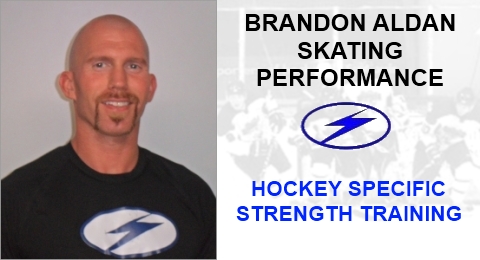Hockey-Specific Strength Training

By: Brandon Aldan – Bio
Strength training is one of the most misunderstood aspects of hockey off-ice conditioning. Hockey is very unique in the biomechanical demands involved and many people make the mistake of using a program designed for athletes of other sports. A lot of hockey players even use bodybuilding programs. Bodybuilders train to build large amounts of muscle and to create a certain look. Unfortunately, this is not very functional for athletic performance, particularly hockey performance.
Most gyms have countless machines that train almost every body part. Most machines attempt to isolate specific muscle groups but, hockey requires the synergistic integration of various muscle groups at any moment Machines also limit the development of many stabilizer muscles which are extremely important for joint stability. Stabilizers are often limiters to on-ice force production rather than the large prime movers. I prefer to train athletes using more “functional” modalities. The term functional is somewhat of a generic term in the fitness and strength and conditioning industry but I use it to refer to something that has greater carryover to on-ice performance. Generally, unilateral (single-limbed) movements are more functional than bilateral movements. For example, a single-leg squat is more functional than the leg press. There are various effective modalities of strength training i.e. dumbbells, barbells, bands, kettlebells, etc. Moreover, some of the best exercises for hockey can be effective with only bodyweight.
One aim of strength training should be to gain a moderate amount of muscle to prepare the body for impact i.e. checking, receiving checks, hitting the boards, falling, etc. The primary aim is to add force to movements without adding too much weight. Building excessive amounts of muscle can actually be a detriment to performance and would also require a time commitment that would detract from skill training. It would also require the hypertrophy (increase in tissue size) of all types of muscle fibers, whereas, hockey training focuses mainly on the fast twitch fibers.
Recent research has shown that the “intent” to lift a weight explosively is a very effective way to stimulate fast twitch muscle fibers. I utilize this in my programs by having athletes use a weight they can normally lift about 8-10 times. They will try to lift the weight as fast as possible until the speed drops significantly, usually at about 6 reps. It is very important that technique does not change. The movement is still very controlled, just faster than normal. In fact, at heavier loads, the bar or implement might not move very fast even though the person is trying to move it as fast as possible.
An extremely important principle to consider is to ensure that muscle groups are balanced. Many inexperienced athletes tend to focus on the anterior muscles which are those that can be seen in the mirror. A beach body isn’t going to score you more goals or prevent injuries. One way to ensure proper balance is to arrange workouts so that opposing muscle groups are worked one after another. For example, pull-ups would follow shoulder presses. Rows could follow bench press.
Hockey primarily uses the core and lower body musculature and a quality strength program should reflect that fact. The muscles of the upper body are important and should be trained sufficiently but a large percentage of the training should be devoted to the core and lower body. The muscles surrounding the hip particularly, the adductors (commonly referred to as the groin muscles) are more stressed in hockey than other sports and should receive special emphasis.
Typically, I design programs using a total body routine, training some upper and lower body muscle groups in each session. I coordinate them so all the muscle groups are trained in two sessions. Another useful split would be upper and lower body. When I utilize this split, I will do two lower body sessions for every upper body session which is typically sandwiched in between. If you are doing a routine that has a split of bench day, chest/bis, arm day, etc., you’re a bodybuilder not a hockey player. You might as well trade in your skates for some tiny trunks and sunless tanning lotion.
Strength workouts should be done at a frequency of about 2-3 times a week during the season and 3-4 times during the off-season. Less frequent training will fail to yield consistent results and more frequency may lead to overtraining or diminishing gains. For most young athletes, double progression can be an effective means of achieving progressive overload. This can be done by selecting a weight that can be done for 8 reps. Each session, try to perform more reps with each weight. Once you can do 12 reps with that weight, increase the weight to a weight that you can do only 8 reps and repeat the process.
More advanced athletes can use lower rep ranges (i.e.3-6 reps) using heavier weights to build strength. The 5×5 method can be effective for this purpose. This method involves doing 5 sets of 5 reps for each exercise and has shown great results for decades.
Technique is perhaps the most important issue of a strength program. Proper technique will maximize gains and avoid injury. The final couple of reps should be difficult but, good form must be maintained. When you can no longer use good form due to muscle fatigue, the set is over regardless of whether you hit your target number of reps. Don’t get caught up on numbers. The main concern should be providing the neuromuscular system with the optimal stimulus for the body to adapt.








